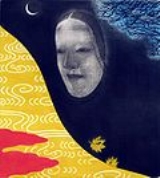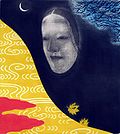
Toru Iwaya
Encyclopedia
is a Japanese
mezzotint
engraver and painter
.
in 1936 as the last child of Iwaya Kanekichi and Kageyama Matsu, Toru Iwaya went, at the age of 19, to Tokyo
. After he graduated from the Tokyo Fisheries (東京水産) now called Tokyo University of Marine Science and Technology
(東京海洋大学) at the age of 24, he moved back to Koriyama where, in 1965 at the age of 29 he married Keiko Sugano.
He then moved to Paris
, the art capital of Europe in 1971, at the age of 35.
The main reason for the Paris move was the search for artistic inspiration. Toru Iwaya is self-taught in painting and engraving and he wanted to be surrounded by an art environment.
 One of the main themes that dominates Toru Iwaya's work is a strong nihilism
One of the main themes that dominates Toru Iwaya's work is a strong nihilism
and the constant internal battle he has faced through his life in searching for answers to life's existential questions.
His mezzotint technique "black technique", which is a method rarely in use today, expresses the deep world featured just beneath the motif that is floating on the black surface.
His nihilism has permeated him and his work, with few exceptions; we can see it as the predominant theme that drives his work.
Another recurrent theme is also the noh
mask. Noh masks are used in the Japanese musical drama since the 14th century.
Many of his works are in galleries around the world, in the National Library of Paris, City Museum of Koriyama, Japan, City Museum of Fukuoka, Japan and the New York Public Library
Due to the poor living conditions he had while living in Paris
, he devoted his energy to his work and the mezzotint technique.
It was during this period that he met and became a personal friend of the master Yozo Hamaguchi. They did several exhibitions together in New York City
.
He personally regarded him as an older brother, a figure superior to himself.
 During this period, he was influenced by many artists famous throughout Europe at that time, such as Paul Klee
During this period, he was influenced by many artists famous throughout Europe at that time, such as Paul Klee
, Odilon Redon
, Marc Chagall
and Joan Miró
. This is particularly evident in the Praise to Klee and Miró work.
Although he was not directly involved in the atomic bombing of Hiroshima and Nagasaki, those two events had a big influence on his work, an influence that continues up until the present time.
His complete work was also published in 1991 in the Catalogue Raisonné
.
He continued his work teaching painting techniques to young students in his atelier.
Japanese people
The are an ethnic group originating in the Japanese archipelago and are the predominant ethnic group of Japan. Worldwide, approximately 130 million people are of Japanese descent; of these, approximately 127 million are residents of Japan. People of Japanese ancestry who live in other countries...
mezzotint
Mezzotint
Mezzotint is a printmaking process of the intaglio family, technically a drypoint method. It was the first tonal method to be used, enabling half-tones to be produced without using line- or dot-based techniques like hatching, cross-hatching or stipple...
engraver and painter
Painting
Painting is the practice of applying paint, pigment, color or other medium to a surface . The application of the medium is commonly applied to the base with a brush but other objects can be used. In art, the term painting describes both the act and the result of the action. However, painting is...
.
Biography
Born in Koriyama, JapanJapan
Japan is an island nation in East Asia. Located in the Pacific Ocean, it lies to the east of the Sea of Japan, China, North Korea, South Korea and Russia, stretching from the Sea of Okhotsk in the north to the East China Sea and Taiwan in the south...
in 1936 as the last child of Iwaya Kanekichi and Kageyama Matsu, Toru Iwaya went, at the age of 19, to Tokyo
Tokyo
, ; officially , is one of the 47 prefectures of Japan. Tokyo is the capital of Japan, the center of the Greater Tokyo Area, and the largest metropolitan area of Japan. It is the seat of the Japanese government and the Imperial Palace, and the home of the Japanese Imperial Family...
. After he graduated from the Tokyo Fisheries (東京水産) now called Tokyo University of Marine Science and Technology
Tokyo University of Marine Science and Technology
is a national university in Japan. The main campus is located in Minato, Tokyo and another campus is in Koto, Tokyo.- History :...
(東京海洋大学) at the age of 24, he moved back to Koriyama where, in 1965 at the age of 29 he married Keiko Sugano.
He then moved to Paris
Paris
Paris is the capital and largest city in France, situated on the river Seine, in northern France, at the heart of the Île-de-France region...
, the art capital of Europe in 1971, at the age of 35.
The main reason for the Paris move was the search for artistic inspiration. Toru Iwaya is self-taught in painting and engraving and he wanted to be surrounded by an art environment.
Personal life

Nihilism
Nihilism is the philosophical doctrine suggesting the negation of one or more putatively meaningful aspects of life. Most commonly, nihilism is presented in the form of existential nihilism which argues that life is without objective meaning, purpose, or intrinsic value...
and the constant internal battle he has faced through his life in searching for answers to life's existential questions.
His mezzotint technique "black technique", which is a method rarely in use today, expresses the deep world featured just beneath the motif that is floating on the black surface.
His nihilism has permeated him and his work, with few exceptions; we can see it as the predominant theme that drives his work.
Another recurrent theme is also the noh
Noh
, or - derived from the Sino-Japanese word for "skill" or "talent" - is a major form of classical Japanese musical drama that has been performed since the 14th century. Many characters are masked, with men playing male and female roles. Traditionally, a Noh "performance day" lasts all day and...
mask. Noh masks are used in the Japanese musical drama since the 14th century.
Many of his works are in galleries around the world, in the National Library of Paris, City Museum of Koriyama, Japan, City Museum of Fukuoka, Japan and the New York Public Library
New York Public Library
The New York Public Library is the largest public library in North America and is one of the United States' most significant research libraries...
The France period
Although he started studying mezzotint engraving technique long before moving to Paris, his most productive period started when he moved to France in 1971.Due to the poor living conditions he had while living in Paris
Paris
Paris is the capital and largest city in France, situated on the river Seine, in northern France, at the heart of the Île-de-France region...
, he devoted his energy to his work and the mezzotint technique.
It was during this period that he met and became a personal friend of the master Yozo Hamaguchi. They did several exhibitions together in New York City
New York City
New York is the most populous city in the United States and the center of the New York Metropolitan Area, one of the most populous metropolitan areas in the world. New York exerts a significant impact upon global commerce, finance, media, art, fashion, research, technology, education, and...
.
He personally regarded him as an older brother, a figure superior to himself.

Paul Klee
Paul Klee was born in Münchenbuchsee, Switzerland, and is considered both a German and a Swiss painter. His highly individual style was influenced by movements in art that included expressionism, cubism, and surrealism. He was, as well, a student of orientalism...
, Odilon Redon
Odilon Redon
Bertrand-Jean Redon, better known as Odilon Redon was a French symbolist painter, printmaker, draughtsman and pastellist.-Life:...
, Marc Chagall
Marc Chagall
Marc Chagall Art critic Robert Hughes referred to Chagall as "the quintessential Jewish artist of the twentieth century."According to art historian Michael J...
and Joan Miró
Joan Miró
Joan Miró i Ferrà was a Spanish Catalan painter, sculptor, and ceramicist born in Barcelona.Earning international acclaim, his work has been interpreted as Surrealism, a sandbox for the subconscious mind, a re-creation of the childlike, and a manifestation of Catalan pride...
. This is particularly evident in the Praise to Klee and Miró work.
Although he was not directly involved in the atomic bombing of Hiroshima and Nagasaki, those two events had a big influence on his work, an influence that continues up until the present time.
His complete work was also published in 1991 in the Catalogue Raisonné
Catalogue raisonné
The typical catalogue raisonné is a monograph giving a comprehensive catalogue of artworks by an artist.The essential elements of a catalogue raisonné are that it purports to be an exhaustive list of works for a defined subject matter describing the works in a way so that they may be reliably...
.
The Japan period
Toru Iwaya returned to Koriyama, Japan in 1999 due to his wife's deteriorating health and his sister's mental illness.He continued his work teaching painting techniques to young students in his atelier.
Often used symbols in Iwaya's works
- Crucifixion of Jesus: This is, as many believe, a symbol of the HolocaustThe HolocaustThe Holocaust , also known as the Shoah , was the genocide of approximately six million European Jews and millions of others during World War II, a programme of systematic state-sponsored murder by Nazi...
and persecutions of the Jews as this happened years before his time as an artist. Toru Iwaya was very sympathetic toward human suffering and especially Jesus' ideals and sympathy, and expressed this through his paintings. - Tree: A symbol of serenity and purity.
- Scenes of the Circus: Harmony of man and animal, which induces creativity in man. Harmony of men living together where one person's failure symbolizes the failure of the entire team.
- Horses: Is a symbol of speed and power.
- Noh mask: Is the exact opposite of the horse, is a symbol of serenity and mysticismMysticismMysticism is the knowledge of, and especially the personal experience of, states of consciousness, i.e. levels of being, beyond normal human perception, including experience and even communion with a supreme being.-Classical origins:...
.

